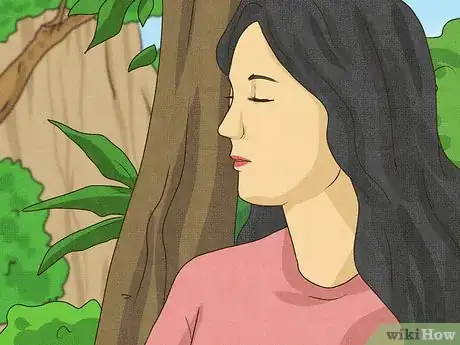wikiHow is a “wiki,” similar to Wikipedia, which means that many of our articles are co-written by multiple authors. To create this article, volunteer authors worked to edit and improve it over time.
There are 16 references cited in this article, which can be found at the bottom of the page.
This article has been viewed 28,149 times.
Learn more...
The ‘Forest Bath,’ or the Japanese medicine of Shinrin-yoku Forest Therapy, can be an exercise in mindfulness and contribute to your well-being. [1] The “bathing” refers to a therapeutic immersion into a natural environment. Since its development in the 1980s by the Japanese Ministry of Agriculture, Forestry and Fisheries, the self-administration of this healing activity has been treated as a preventive measure. It can be completed through a few easy steps. [2]
Steps
Preparing for a Forest Bath
-
1Set aside the time necessary for this therapeutic exercise.
- For a single forest bathing session, set aside two to four hours for an excursion that is at least a half-mile long.[3] Keep in mind that this extended time frame involves several stops for becoming aware of your senses, moments of sitting still, and mindful immersion. The time frame may be increased, but two consistent hours of exposure to this outdoor therapy environment will maximize noticeable improvements to mood and overall health.
- It is important to note that like any other therapeutic exercise, forest-bathing will require multiple sessions. It should not be treated as a one-time only treatment. Performing forest baths multiple times will improve your ability to heal and you will learn to better engage with the forest environment with each session.
-
2Attempt at least one session of forest bathing from a certified guide, if possible.
- A list of guided forest bathing programs is provided by the Association of Nature and Forest Therapy (ANFT). Guides provided on this list can be found worldwide and are trained by ANFT. These programs can be done as a one-on-one or a group therapy experience depending on the guide and location.
- Guides are recommended for beginners due to their limited knowledge of trails and capacity to direct attention to known points of observation.[4]
Advertisement -
3Take vital measurements if you would like to chart your progress and to keep track of your stress levels. These biometric indicators can also help you find what specific activities work best for you.
- Visit your physician for a frequent monitoring of vital signs over time as you engage in multiple sessions of forest therapy.
- Several wearable devices can also monitor biological signs of stress. Some suggested biometric measurements to monitor include your heart rate, blood pressure, sleep tracking, and cortisol levels.
- It is suggested that regular forest bathing sessions may lead to reduced blood pressure, lower pulse rates, decreased cortisol levels, and better sleep patterns.[5] Although it's not directly possible to monitor these results, this therapy may increase energy levels, improve mood, and boost your body’s immunity.[6] Forest bathing, when carried out successfully over a course of regular sessions, should change cerebral blood flow so as to reflect the mind in a state of relaxation.[7]
- You may also choose to self-administer a Profile of Mood States (POMS) Test before and after your forest bathing session. This questionnaire will document any changes in psychological responses.[8]
-
4Take proper precautions to remain restful and peaceful in the forest setting. These preparations will make the therapy session much more comfortable.
- Before venturing out, make sure you use proper sun protection to prevent any adverse health effects.
- During certain seasons, the presence of pollen may be irritating, so it is important to take any prescribed allergy medication.
- Use bug spray on your body to repel insects and prevent any harmful bites that could distract you from forest bathing.
- Leave behind or silence any technological distractions. This will allow you to attend to the immediate experience in the natural setting.[9]
- For mental preparation, the ANFT suggests that you “work with the forest as a partner.” This means that the forest bathing should be framed as an exercise without a final goal for the forest bathing session. The emphasis is on sensory awareness in an area that does not have a lot of other people/distractions around.
Doing Your Forest Bath
-
1Find a suitable location in nature. The setting for a forest bath does not necessarily need to be dense with trees. Any kind of natural setting with minimal human-built features is suitable. The chosen location should be filled with interesting features that improve opportunities for observation and various sensory activities.
- Environments rich with trees will allow for direct engagement through touch. The sound of streams or ponds will enhance the experience. Flowered meadows are also desirable for scent-based engagement. A combination of closed spaces, like canopy-dense forest areas, and open spaces, like meadows, provide the best forest-bathing trails because they allow for a diversity in light and sound.
- If you are not, or have not, worked with a guide, research nearby forest areas to find one with clear, accessible, and easily navigable trails. This will allow you to relax and focus on your surroundings during the excursion rather than remaining anxious and on guard. Also remember that this is not meant to be physically-challenging, but peaceful. Trails clear of physical barriers are best.
- Choose a location near your home that can be accessed time and time again. Performing forest baths frequently will not only increase your familiarity with this type of terrain, but also enhance their therapeutic effects.[10]
-
2Enter the forest, stand still, and recognize your body in space. This step should take around 15 to 20 minutes to complete. Consider this step to be like stretches before an exercise.
- When you enter the forest, do not automatically begin to navigate. Instead, stand in one spot and really immerse yourself in the environment. Take note of your surroundings. Quietly list what you notice. This can be trees, rocks, water features, or animals.[11]
- Make sure you recognize your body in relation to the surroundings. Feel your feet firmly planted on the ground. You may also pick up a small rock, branch, or leaf. Move this natural object around in your hands and concentrate on how you interact with this object. This means that you pay attention to not just your skin’s contact with the object, but how your muscles and bones change their position to adjust to its place in your hands.
- Beyond touching and seeing objects, make note of less visible, natural elements. Note the sounds that you hear. These noises may be birds chirping, water splashing, or leaves rustling in the wind.
- Recognize the air in its smell and texture. Try to understand how it hits your skin and enters your body. Breath in slowly and exhale to notice the smells of nature. Do not breathe too loudly, but rather attempt to have your noises blend in with the sounds of the forest. Closing your eyes during this part gives you easy access to mindful engagement with your other senses.
-
3Breathe in the smells of the forest. Find places with rich aromas of soil or flowers.
- If you appreciate certain smells, or find some scents more calming than others, it may be important to keep your preferences in mind when choosing a location.
- Certain tree scents can also have particular benefits. Cedars, birch trees, among other plant-life produce valuable phytoncides which increase the number of disease-fighting white blood cells in the body.[12]
-
4Proceed with the bath by walking forward mindfully.
- Move very slowly and walk quietly, then try and move your body in tune with the natural rhythm of the forest. Mirror any calm motions you see, such as the slight movement of leaves due to a calm breeze.[13]
- Pay attention to how your breathing pattern while you are walking. This can help tune your whole body to your surroundings. Each breath in should be accompanied by the lifting of one leg. Its placement back on the ground should occur as you exhale.[14]
- If at any point, there is some frenzied or rushed motion within you, return to Step 6 to re-center and re-recognize your body’s relationship to the environment. If you want to continue your movement without standing still, attempt to match your breathing patterns to your walking motions once more.
-
5Reflect out loud. Once your body gains a sense of comfort in its movement, speak your observations out-loud as you walk.
- Instead of a simple mental note of observations, share with the forest what you see. Begin each sentence with the phrase: “I am noticing…” and add in your personal observations. Direct your speech to particular natural objects or animals that may cross your path.[15]
-
6Establish a sit spot and sit in one location for a minimum of 20 minutes.
- Find a comfortable location where you can sit for an extended period of time. This can be a dry spot in a meadow, a tree stump or fallen log, or a large boulder. Avoid anything that may disturb animal habitats. Try and find visual markers to make this spot a landmark. You may choose to return to it frequently in later forest bathing sessions.
- Once you find your location, sit down. Quietly observe your surroundings for at least 20 minutes.[16]
-
7Return to mindful walking and continue with the bathing session.
- Interspersing walking and sitting is a technique to keep in mind, as it maximizes the forest bathing experience.
-
8Conclude your session, but do not make an immediate return to everyday life. Find some ceremonial activity, like drinking tea, to mark the end of the forest bathing process.
- Traditionally, the Japanese shinrin-yoku sessions conclude with a tea ceremony.[17] This allows ample time to reflect outside of the mindful activities of forest bathing. If tea does not hold a cultural or calming significance to you, consider a light snack or a water or juice beverage to feed you during this reflective process.
- Keep in mind that this is not meant to be a mindful eating experience but a slow break from the mindfulness in forest bathing.
- If you are with other people, engage in some light conversation about the forest bathing you just experienced. The goal is to move away from the immersive session in nature back to the rhythm of urban life. This time is called the “Threshold of Incorporation” and allows one to slowly transition back into everyday life.[18]
References
- ↑ https://www.npr.org/sections/health-shots/2017/07/17/536676954/forest-bathing-a-retreat-to-nature-can-boost-immunity-and-mood
- ↑ Selhub, E. M., & Logan, A. C. (2012). Your Brain On Nature: The Science of Nature's Influence on Your Health, Happiness and Vitality. Mississauga, ON: John Wiley & Sons.
- ↑ Clifford, M. A. (2018). Your Guide to Forest Bathing: Experience the Healing Power of Nature. Newburyport, MA: Conari Press, 43.
- ↑ Clifford, M. A. (2018). Your Guide to Forest Bathing: Experience the Healing Power of Nature. Newburyport, MA: Conari Press, 139-140.
- ↑ Selhub, E. M., & Logan, A. C. (2012). Your Brain On Nature: The Science of Nature's Influence on Your Health, Happiness and Vitality. Mississauga, ON: John Wiley & Sons.
- ↑ Selhub, E. M., & Logan, A. C. (2012). Your Brain On Nature: The Science of Nature's Influence on Your Health, Happiness and Vitality. Mississauga, ON: John Wiley & Sons.
- ↑ Selhub, E. M., & Logan, A. C. (2012). Your Brain On Nature: The Science of Nature's Influence on Your Health, Happiness and Vitality. Mississauga, ON: John Wiley & Sons.
- ↑ Li, Q. (2009). Effect of forest bathing trips on human immune function. Environmental Health and Preventive Medicine, 15(1), 9-17. doi:10.1007/s12199-008-0068-3
- ↑ https://www.growwilduk.com/blog/5-simple-steps-practising-shinrin-yoku-forest-bathing
- ↑ Van den Bosch, M., & Bird, W. (2018). The Oxford Textbook of Nature and Public Health: The Role of Nature in Improving the Health of a Population. New York, NY: Oxford University Press, 151.
- ↑ https://www.abc.net.au/everyday/beginners-guide-to-japanese-forest-bathing/10369284
- ↑ http://time.com/4718318/spring-exercise-workout-outside/
- ↑ https://www.abc.net.au/everyday/beginners-guide-to-japanese-forest-bathing/10369284
- ↑ Hanh, T. N. (2015). How to Walk. Berkeley, CA: Parallax Press.
- ↑ Clifford, M. A. (2018). Your Guide to Forest Bathing: Experience the Healing Power of Nature. Newburyport, MA: Conari Press, 47.
- ↑ Elevitch, C. R. (2004). The Overstory Book: Cultivating Connections with Trees. Holualoa, HI: Permanent Agriculture Resources, 474.
- ↑ Clifford, M. A. (2018). Your Guide to Forest Bathing: Experience the Healing Power of Nature. Newburyport, MA: Conari Press, 80.
- ↑ Clifford, M. A. (2018). Your Guide to Forest Bathing: Experience the Healing Power of Nature. Newburyport, MA: Conari Press, 82.
- ↑ Li, Q. (2018). Shinrin-Yoku: The Art and Science of Forest Bathing. London, UK: Penguin.
- ↑ Wilson, E. O. (1984). Biophilia. Cambridge, MA: Harvard University Press.





































































Medical Disclaimer
The content of this article is not intended to be a substitute for professional medical advice, examination, diagnosis, or treatment. You should always contact your doctor or other qualified healthcare professional before starting, changing, or stopping any kind of health treatment.
Read More...